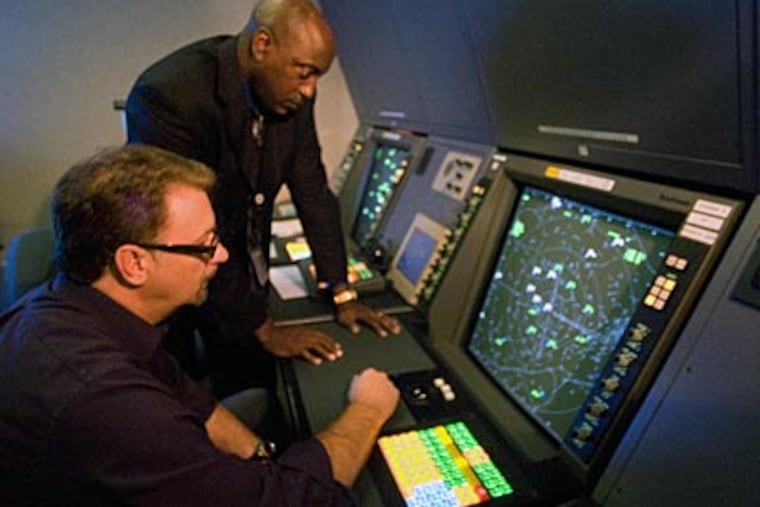Phila. is test site of new satellite-surveillance radio system
Phila. is one of 4 sites that have the NextGen system, which uses GPS.

At Philadelphia International Airport's busy tower, air traffic controllers showed off new satellite technology Monday that will one day transform the nation's air traffic system from radar navigation to an Internet in the sky.
Philadelphia is one of four airports to get the technology, which relies on global positioning satellites, like GPS in a car, to transmit a plane's location to radios on the ground, controllers in towers, and to other aircraft nearby.
"Philadelphia is a pioneer site," said Federal Aviation Administration vice president Victoria Cox, announcing that Philadelphia controllers now have the capability to track planes equipped with the technology, known as Automatic Dependent Surveillance Broadcast, or ADS-B.
It's part of a nationwide aviation overhaul - called Next Generation, or NextGen - that the FAA hopes will be largely operational by 2018.
By 2020, all aircraft flying in U.S. airspace must have the ADS-B devices in their cockpits.
Philadelphia is a demonstration site because United Parcel Service is here and has equipped 100 aircraft with satellite-technology. US Airways Group Inc. is in the process of equipping some of its planes, the FAA said.
Philadelphia controllers also use a computer system, called STARS, that takes information, including the ADS-B signals, and translates it to the screens controllers look at.
In addition, Philadelphia was selected to get some of the first satellite-surveillance radios because of its location in congested East Coast air space. The other test sites are Louisville, Ky., where UPS is based; Houston; and Juneau, Alaska.
Seven ground radios - each about the size of two refrigerators - have been installed around Philadelphia, including two on airport property. They will be part of a network of 813 radios by 2013, the FAA said.
Once airplanes get specialized GPS devices in cockpits, pilots will transmit via satellite to ground radios, which will bounce information to control towers. Controllers, in turn, will transmit to the radios, which will broadcast up to the cockpit.
The new technology will allow pilots, for the first time, to see what controllers see: other aircraft in the sky around them, bad weather and terrain, and information such as temporary flight restrictions.
The problem with radar is not safety but efficiency. Radar has gaps in coverage - in mountains and over water, such as the Gulf of Mexico.
Because radar updates more slowly, aircraft are kept five nautical miles apart to ensure safety. Satellite technology updates continuously, and controllers will be able to reduce the mandatory separation between aircraft, which the FAA says will improve efficiency in airspace, allow planes to fly more direct routes, and use less fuel.
"Radars work great; they are very safe," said Vincent Capezzuto, FAA director of surveillance and broadcast services. "They have different update rates and accuracy levels. The fastest radars rotate at about 4.8 seconds. The new technology will be once a second."
GPS in airplanes is the same satellite network as GPS in cars.
"The difference is we are wiring it up to a radio that broadcasts the information out," Capezzuto said.
Philadelphia air traffic controllers have been using the satellite technology since March 28, mostly on UPS airplanes, said Arthur Sullivan, FAA project manager for Philadelphia. UPS is the only carrier flying here regularly with ADS-B technology on board.
Several small general-aviation aircraft in Lancaster have the equipment, as do 30 helicopters in the Gulf of Mexico. "US Airways is going to outfit 20 planes over the next few months," Sullivan said.
The technology has been tested on general-aviation aircraft in Alaska, where the accident rate fell by 47 percent because of greater accuracy and reliability of satellite signals, according to the FAA.
Airlines, including Southwest, American, and United, have GPS capability on planes but do not have the devices on board yet to communicate via satellite with ground radios and airport towers.
"Southwest uses GPS to tell the airplane where it is, and navigate a route to the airport based on its GPS track," said the FAA's Cox. "NextGen is navigation, surveillance and communication. It does the same thing radar does in terms of knowing where all the aircraft are."
"The goal everyone is shooting for is 2020," said FAA spokesman Paul Takemoto. "It's not like you flip a switch and one day everyone uses ADS-B. It's a huge system. There are 5,000 aircraft in the sky at any moment, 3,700 commercial flights per day."
Radar tracking of aircraft will not totally disappear. "We will reduce the radar infrastructure," Capezzuto said, "because this supplements it. We don't see radars going away 100 percent."